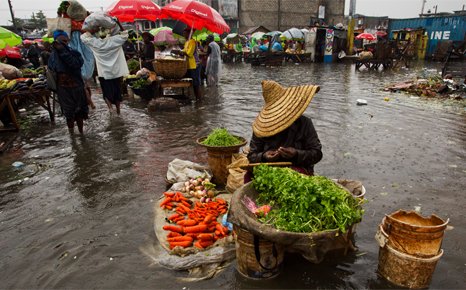
Climate change can be defined as a change in the temperature and weather conditions on various levels including regional ones (May, 2011). Climate change is sped up by human actions of production and consumption, and in its current form is expected to become a threat to food security by increasing sea levels and causing significant changes in average temperatures (May, 2011). Even though climate change by itself is not necessarily detrimental for food security it is a key breaking-point driver as it usually adds on to already vulnerable socio-economic situations with limited political will and means to deal with food insecurity (Gregory et al. 2005).
As a primary driver, climate change can contribute to food insecurity through extreme physical changes to agricultural land, temperatures, changes in rainfall and the lengths of seasons, which can reduce the supply of agricultural foods and agricultural means for an income (Gregory et al. 2005). According to a National Intelligence Council Report (2012: iv) climate change is a “food production wildcard” because it can affect crop yields either positively or negatively depending on how climate change affects rainfall patterns and temperature.
In some cases, regions such as Russia, Central Asia, North America and Northern Europe, will benefit from climate change by creating additional cultivable land due to increases in temperature (Devereux and Edwards, 2004). The region that will experience “negative” climate change the most is SSA, where it is estimated that around 200 million people are food insecure and 70% of them are dependent on agricultural for their livelihoods due to increased droughts and changes in seasons (The National Intelligence Council Report, 2012). Additionally, the positive effects of climate change for some countries cannot outweigh the uncertainty that it causes on the global scale.
As a secondary driver, climate change can influence food prices and heighten existing inequalities in NFS as well as increase conflictual tension over access to food and food production, which can in turn cumulate to further affect food insecurity. In terms of the NFS, climate change has played a role in contributing to high food prices which are impacting the import bills of developing countries and the food infrastructure (Gregory et al. 2005).
Trends from the last five years show that food prices have increased due to changes in climate and biofuel policies as well as increased pressures on natural resources such as land (Ringler et al. 2010). By 2050 it is expected that SSA will face a tremendous increase in its food import bills, which will also perpetuate a vicious cycle, increasing food insecurity (Ringler et al. 2010). Additionally, climate change has also been contributing to various disputes and conflicts in SSA and beyond. According to a study conducted by the UN environment program the conflict in Darfur which has led to around 200,000 deaths has been “driven by climate change and environmental degradation”, and has had devastating impacts on the livelihoods pressures on pastoral societies and their consequent access to food (Vidal, 2011).
Another study conducted by Bond (2014) emphasizes how in Kenya the dynamics of conflict are highly depended on environmental degradation and competition over natural resources, which has led to a loss in livelihood resources and/or subsistence, affecting food security. Climate change can play a role aggravating the inequalities in the NFS through reductions in supply of agriculture pushing up food prices and it can increase the likelihood of conflict in extreme situations which in turn can further drive food insecurity.
Before the 1980s, food insecurity and famines were often conceptualized as apolitical and technical caused by natural phenomena with supply-side effects. These theories were heavily influenced by Malthusian thought which had conceptualized famine as a “balancing mechanism” in response to population pressures on the availability of food (Edkins, 2002). Although some environmental determinists argue that his theory can still be applied today and in the future, it does not account for regional disparities and socio-economic abilities of countries to address climate change (Gregory et al. 2005).
Questions in terms of who is emitting most of the harmful gases and who it affects need to be addressed globally if we want to stop the breaking-point effect of climate change. Estimations show that the effects of climate change can be reduced by one third if various adaptations are adopted such as crop technology and shifts in cultivation areas and exports, as well as changes in tenure systems (Devereux and Edwards, 2004: 26). The investigation into suitable solutions and implementation of these solutions requires political will primarily on the international level (Devereux and Edwards, 2004: 28).
Congratulations @fleurdb! You received a personal award!
You can view your badges on your Steem Board and compare to others on the Steem Ranking
Vote for @Steemitboard as a witness to get one more award and increased upvotes!